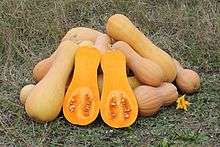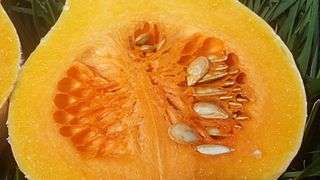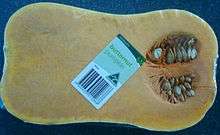Butternut squash
Butternut squash (Cucurbita moschata), sometimes known in Australia and New Zealand as butternut pumpkin or gramma,[1] is a type of winter squash that grows on a vine. It has a sweet, nutty taste similar to that of a pumpkin. It has tan-yellow skin and orange fleshy pulp with a compartment of seeds in the blossom end. When ripe, it turns increasingly deep orange, and becomes sweeter and richer. It is a good source of fiber, vitamin C, magnesium, and potassium; and it is a source of vitamin A.
| Cucurbita moschata 'Butternut' | |
|---|---|
 Ripe butternut squash | |
| Species | Cucurbita moschata |
| Hybrid parentage | 'Gooseneck squash' × 'Hubbard squash' |
| Breeder | Charles Leggett |
| Origin | 1940s in Stow, Massachusetts, United States |


Although botanically a fruit, butternut squash is used culinarily as a vegetable that can be roasted, sautéed, toasted, puréed for soups such as squash soup, or mashed to be used in casseroles, breads, muffins, and pies. The squash is also used as an alternative diet for Monarch butterfly caterpillars alongside cucumbers. It is part of the same squash family as ponca, waltham, pumpkin, and calabaza.[2]
History
The word "squash" comes from the Narragansett word askutasquash, meaning "eaten raw or uncooked". Although Native people may have eaten some forms of squash without cooking, today most squash is eaten cooked. Native Americans believed that it had extreme nutritional properties and would bury their dead with it to sustain them on their final journey.[3]
The late-growing, less symmetrical, odd-shaped, rough or warty kinds, small to medium in size, but with long-keeping qualities and hard rinds, are usually called winter squash.
Spread from South and Central America
All three species of squashes and pumpkins are native to the Western Hemisphere. C. maxima, represented now by such varieties as Hubbard, Delicious, Marblehead, Boston Marrow, and Turks Turban, apparently originated in northern Argentina near the Andes, or in certain Andean valleys. At the time of the Spanish invasion it was found growing in such areas and has never since been found elsewhere except as evidently carried by man.
Since this is a plant that requires a fair amount of hot weather for best growth, it has never become very well known in northern Europe, the British Isles, or in similar areas with short or cool summers. Only long-vining plants are known in this species.
C. moschata, represented by such varieties as Cushaw and Winter Crookneck Squashes, and Japanese Pie and Large Cheese Pumpkins, is a long-vining plant native to Mexico and Central America. This species and C. pepo apparently originated in the same general area, Mexico and Central America. Both are important food plants of the natives, ranking next to maize and beans. The flowers and the mature seeds, as well as the flesh of the fruit, are eaten in some areas.
Before the arrival of Europeans, C. moschata and C. pepo had been carried over all parts of North America where they could be grown, but they had not been carried into South America as had beans, which originated in the same general region. They were generally grown by American Natives all over what is now the United States. Many of these tribes, particularly in the West, still grow a diversity of hardy squashes and pumpkins not to be found in generic markets.
Although winter squashes are grown in many lands today, they are relatively unimportant with few exceptions. They are grown extensively in tropical America, in Japan, in Northern Italy and in certain districts in the United States. The calabazas of the West Indies and the forms grown by the natives of present-day Mexico and Central America are not of uniform, pure varieties, but are extremely variable as to size, shape, and color. Since these species are normally cross-pollinated, it is difficult to keep a variety pure.
Butternut squash however is modern variety of winter squash. It was developed by Charles Legget of Stow, Massachusetts in 1944.[4]
Attributes
Butternut squash will store for two to three months. They are best kept at 10 °C (50 °F) with 50 percent humidity.[5]
Nutrition
| Nutritional value per 100 g (3.5 oz) | |
|---|---|
| Energy | 188 kJ (45 kcal) |
11.69 g | |
| Dietary fiber | 2 g |
0.1 g | |
1 g | |
| Vitamins | Quantity %DV† |
| Vitamin A equiv. | 67% 532 μg39% 4226 μg |
| Thiamine (B1) | 9% 0.1 mg |
| Riboflavin (B2) | 2% 0.02 mg |
| Niacin (B3) | 8% 1.2 mg |
| Pantothenic acid (B5) | 8% 0.4 mg |
| Vitamin B6 | 12% 0.154 mg |
| Folate (B9) | 7% 27 μg |
| Vitamin C | 25% 21 mg |
| Vitamin E | 10% 1.44 mg |
| Minerals | Quantity %DV† |
| Calcium | 5% 48 mg |
| Iron | 5% 0.7 mg |
| Magnesium | 10% 34 mg |
| Manganese | 10% 0.202 mg |
| Phosphorus | 5% 33 mg |
| Potassium | 7% 352 mg |
| Zinc | 2% 0.15 mg |
| |
| †Percentages are roughly approximated using US recommendations for adults. Source: USDA Nutrient Database | |
A 100g serving of butternut squash contains 45 calories, 11.69 grams of carbohydrates, 2 grams of fiber, 1 gram of protein, and negligible fat content and is a rich source of vitamin A and a moderate source of vitamin B6, vitamin C, and vitamin E. It also contains moderate levels of magnesium and manganese.
Butternut squash seeds have been cited for reducing social anxiety disorder within an hour of consumption in a double-blind trial.[6]
Culinary uses
One of the most common ways to prepare butternut squash is roasting. Once roasted, it can be eaten in a variety of ways.[7] The fruit is prepared by removing the skin, stalk, and seeds, which are not usually eaten or cooked.[8] However, the seeds are edible, either raw or roasted, and the skin is also edible and softens when roasted. The seeds can even be roasted and pressed into an oil to create butternut squash seed oil. This oil can be used for roasting, cooking, on popcorn, or as a salad dressing. [9]
In Australia, it is regarded as a pumpkin, and is used interchangeably with other types of pumpkin.[4]
In South Africa, butternut squash is commonly used and often prepared as a soup or grilled whole. Grilled butternut is typically seasoned with spices such as nutmeg and cinnamon or stuffed (e.g. spinach and feta) before being wrapped in foil and grilled. Grilled butternut is often served as a side dish to braais (barbecues) and the soup as a starter dish.
Butternuts were introduced commercially in New Zealand in the 1950s by brothers Arthur and David Harrison who were nurserymen and market gardeners in Otaki.
See also
References
- "Commercial production of pumpkins and grammas". Department of Agriculture and Fisheries. Archived from the original on 6 August 2016. Retrieved 29 June 2016.
- GourmetSleuth. "Butternut Squash". Gourmet Sleuth. Retrieved 29 March 2020.
- "The History of Butternut Squash". Our Everyday Life. Retrieved 29 March 2020.
- "The strange history of the butternut". Farmer's Weekly. 21 September 2013. Retrieved 29 March 2020.
- Munro, Derek B.; Small, Ernest (1997). Vegetables of Canada. NRC Research Press. p. 179. ISBN 9780660195032. Retrieved 2 February 2020.
- Michael Greger, M.D. (2015) How Not To Die: Discover the Foods Scientifically Proven to Prevent and Reverse Disease, p. 205.
- Randhawa, Jessica (3 September 2018). "Butternut Squash". The Forked Spoon. Retrieved 20 November 2019.
- "Butternut Squash". Veg Box Recipes. 2008. Archived from the original on 28 September 2013. Retrieved 15 September 2013.
- Bilow, Rochelle. "Butternut Squash Seed Oil Is Exactly What Your Pantry Has Been Missing". Bon Appétit. Retrieved 15 June 2020.
External links
| Wikispecies has information related to Cucurbita moschata |
| Wikimedia Commons has media related to Cucurbita moschata bell group. |
